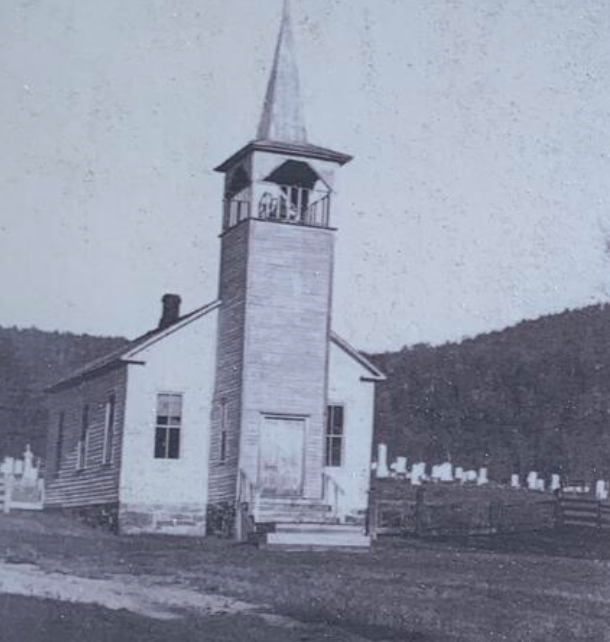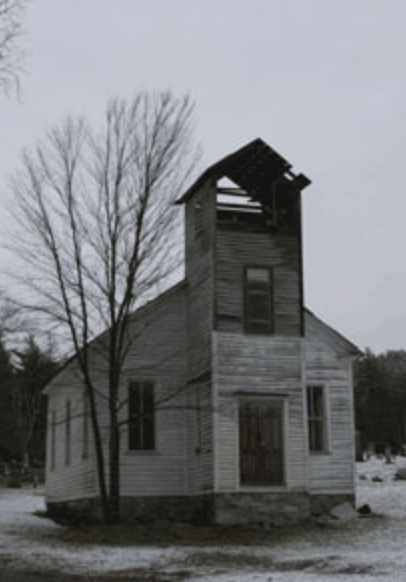The Underground Railroad at Darrowsville
Many thanks to Donna Lagoy and Laura Seldman for contributing to our project this chapter from The Underground Railroad in the Adirondack Town of Chester, which they published in 2016 with support from the Town of Chester Historical Society. It’s a beautiful book, lavishly illustrated with Laura’s photographs. Donna and Laura provide a brief history of the Underground Railroad, and offer site descriptions and interviews focused on ten sites in Chester believed to be stations on the Underground Railroad.
They started their research in 2012 when the town was trying to figure out what to do with the crumbling remains of the Darrowsville Wesleyan Methodist Church. After producing a short fundraising pamphlet, they spent three years exploring sites and interviewing their owners to tell the larger story. Laura photographed the places and artifacts, while Donna focused on local newspaper websites and histories of other towns, such as Minerva, Schroon Lake, and Warrensburg.
”The people who supported the Darrowsville and Mill Creek churches were wholly dedicated to the welfare of the community and believed strongly in the abolitionist movement," says Donna. "They had a great community spirit. It appears that quite a few merchants were happy to support this movement, perhaps because they felt it would be better for the town."
The Darrowsville Wesleyan Methodist Church was located three miles south of Chestertown on Dennehy Road. It was part of a thriving community known as Darrowsville.
The second pastor to serve the Darrowsville Wesleyan Methodist Church was the abolitionist Rev. Thomas Baker, who is believed to have hidden slaves in the parsonage.
In February 1843 there was a preliminary convention held at Andover, Massachusetts, that approved the formation of local Wesleyan Societies pending the establishment of a general organization. This split in the Methodist Church, known as the Great Schism, was caused by the disagreement between those who protested slavery and the use of alcoholic beverages and wanted that to be the prime focus of the church and those who saw no reason to change.
A great convention was called in Utica, New York, on May 31, 1843, and the Wesleyan Methodist Connection was formed. The Wesleyan discipline differed considerably from the Methodist Episcopal Church in that it prohibited slaveholding and the use of intoxicating beverages.
That same year, on July 14, 1843, the Wesleyan Methodists at Darrowsville were organized. It is reputed to be one of the first churches organized after the formation of the Wesleyan Connection. It was first known as the Warrensburgh Class.
In 1855, by an act of the Warren County Board of Supervisors, a one-mile strip of land from the Schroon to the Hudson Rivers was taken from the Town of Warrensburgh and given to the Town of Chester. Afterward the church is listed in records as the Darrowsville Class. Thomas Baker and Myron Tripp helped to organize the Wesleyan Methodist Church at and later to build the church structure. Reverend John Wood was the first pastor until 1845. He is buried at the Darrowsville Cemetery.
In The Underground Railroad from Slavery to Freedom, written in 1898 by Wilbur H. Siebert, Mr. Siebert says, "Indeed, it came to be said of the Wesleyans, as of the Quakers, that almost every neighborhood where a few of them lived was likely to be a station of the secret Road to Canada."
The Darrowsville Wesleyan Methodist Church building was erected in 1845 on an acre of land obtained from Orange Woodhouse by a deed dated June 16, 1845. This would hold the church building and an adjacent cemetery. The building was a white frame structure with a simple bell tower housing a 3-foot bell. It is not known what happened to that first bell. In 1895, a bell from Rumsey & Company, Limited, in Seneca Falls was installed in a larger, added bell tower. The 3-foot bell cost $37.50.
The building was 28 feet by 23.5 feet and could seat 150 people. There was no plumbing and no electricity, and the only heat it had was from a potbellied wood stove. The church and a parsonage were built on the Wood homestead. The parsonage was destroyed in a fire in 1850, and the early church records were lost. The trustees of the church later sold the property where the parsonage had stood.
Another church at Darrowsville, the Methodist Episcopal Church, was organized in 1856. This church did not survive and by 1876 had disappeared.
Reverend Thomas Baker was the second pastor and the first abolitionist pastor of the Darrowsville Church. It is believed that he hid fugitive slaves in the parsonage. According to an obituary written for Eunice Baker, the Reverend Baker's widow, Thomas Baker was well known throughout northern New York for his identification with the antislavery movement.*
Another abolitionist pastor who served the Darrowsille Wesleyan Methodist Church was Reverend S.H. Foster He was a staunch abolitionist and served many churches throughout northern New York and one in Vermont. He served as pastor of the Darrowsville Church three separate times. He married Jane Ann Tripp, a local girl. Their son Matt Foster married Julie Oliviere, another local girl, who afterward gained fame as Jeanne Robert Foster, a writer and poet of the early 1900s. Reverend S.H. Foster died in 1893. He and his wife, Jane, are buried a Chester Rural Cemetery.
Building the Memorial
In 1897, the membership of Darrowsville was united with the Brant Lake Church. The Darrowsville charge continued, and regular services were held until 1930. Services were then held intermittently, mostly in summers, until 1937.
By 2012, the church was on its way toward collapsing.
There were two attempts, which failed due to lack of attendance, to revive services in 1940 and 1954. The church sat abandoned after that.
There were two attempts to restore the church, one in 1976 and one in 1982. But the question of ownership of the church arose. The original 1845 deed was the only known deed; there was never any deed found to divide the church property from the original property.
The Wesleyan Methodist organization gave the church to the Town of Chester in 1976, but there was never any legal paperwork filed. In 2011 the Historical Society of the Town of Chester obtained a quit claim deed to the church and the adjacent cemetery. Over the years the church had lost its roof, and one side had partially collapsed.
In 2012 it was deemed unsafe and was deconstructed. Plans were made to build a memorial on the footprint of the original church and relocate the bell in housing made from church timbers. Fundraising began, and those plans were realized by 2016, with storyboards that tell the story of the hamlet of Darrowsville and its role in the Underground Railroad.
The Darrowsville Memorial is located a short distance from the intersection of Route 9 and Dennehy Road. Drive past the sawmill and you will see the memorial and cemetery on your right. There is a handicap parking space and benches to sit on. You can read the story of this important settlement and its crucial role in the Underground Railroad movement.
The Chestertown Historical Society raised the funds to build this memorial on the site, where you’ll find a synopsis of the church’s story.




